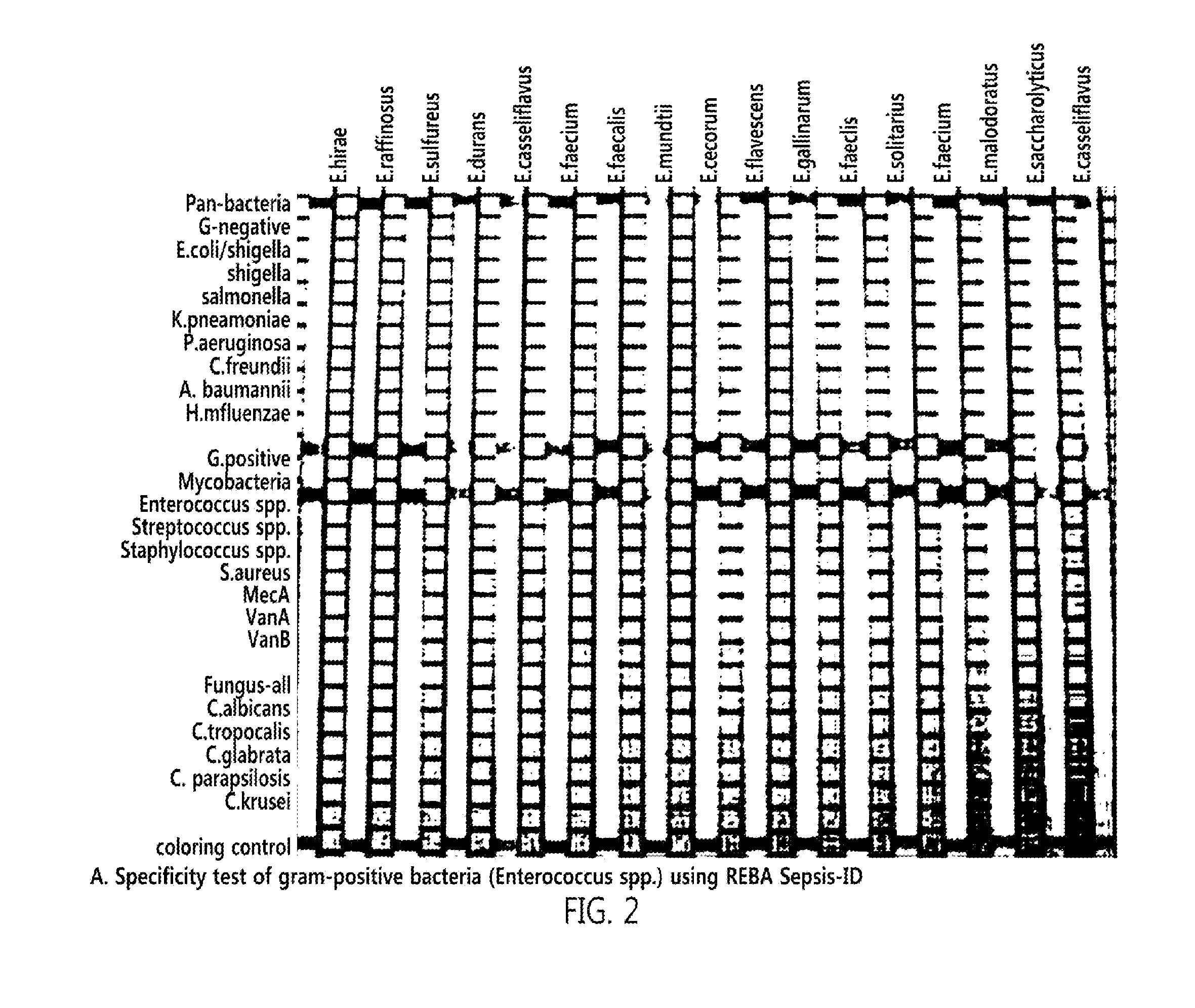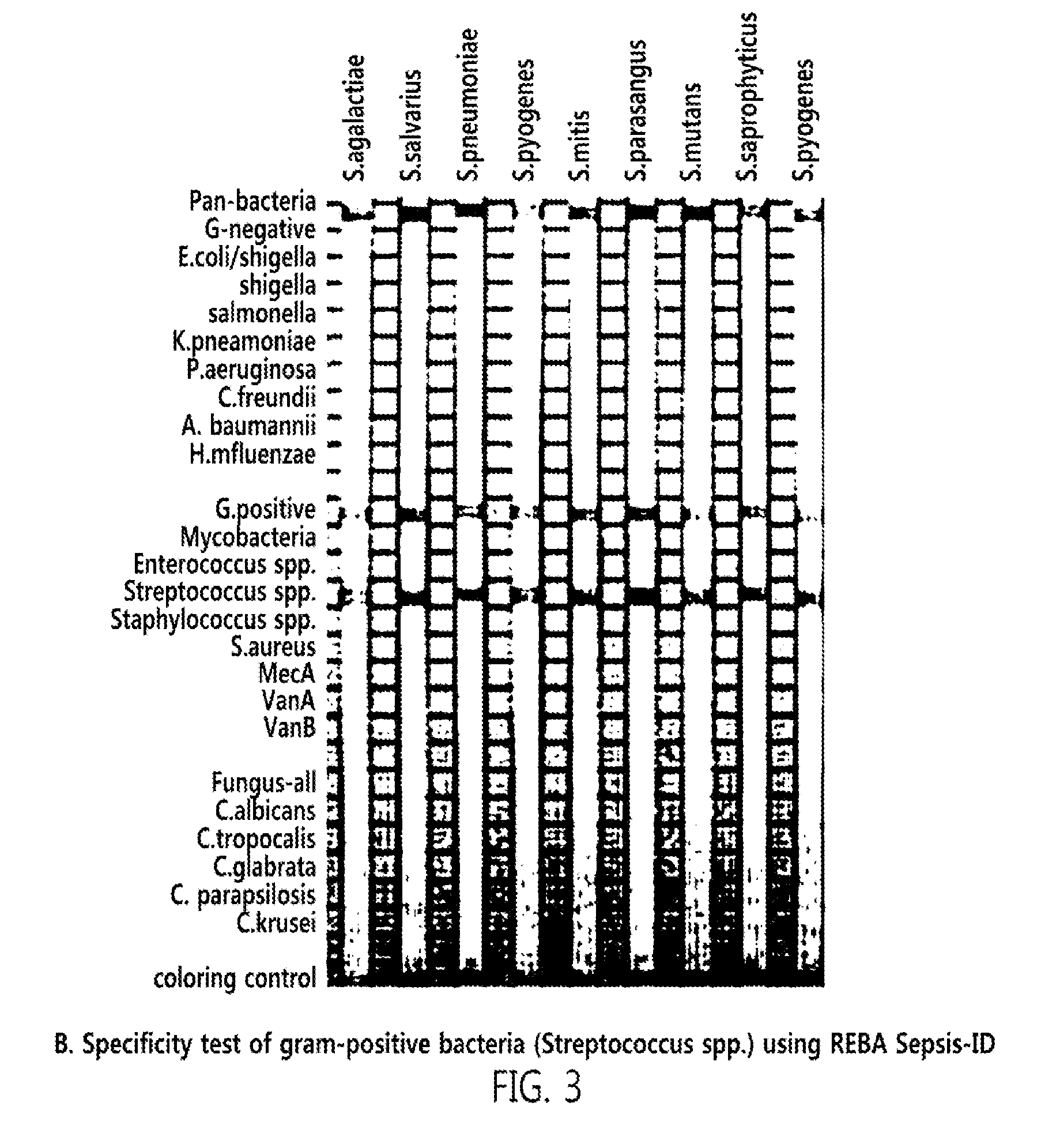Composition for Diagnosing Sepsis, and Method and Kit Therefor
a sepsis and composition technology, applied in the field of composition for diagnosing sepsis, can solve the problem that blood culture typically takes 5 days or more, and achieve the effect of rapid and accurate identification methods and the confirmation of usefulness
- Summary
- Abstract
- Description
- Claims
- Application Information
AI Technical Summary
Benefits of technology
Problems solved by technology
Method used
Image
Examples
example 2
Extraction of Genomic DNA from Reference Strain and Clinical Isolate
[0046]A part of a culture medium cultured in a BACTEC 9240 system (Becton Dickinson Microbiology System, Sparks, Md, USA) was obtained. 100 μl of a DNA extraction solution was put into the obtained culture medium, vortexed for 1 minute, heated at 100° C. for 10 minutes, and centrifuged at room temperature at 13,000 rpm for 3 minutes so as to obtain a supernatant. A nucleic acid was separated by using this method. The separated nucleic acid was used as a template of a PCR for implementing Real GP-GN / Real Can and REBA Sepsis-ID.
example 3
Gene Collection and Analysis in Real GP-GN / Real can and REBA Sepsis-ID
[0047]From Genbank of National center for biotechnology information (NCBI, http: / / www.ncbi.nlm.nih.gov)), as targeted PCR primers and oligonucleotide probes for accurate identification of a bacterial species of sepsis, a 16s rRNA gene for detecting gram-positive bacteria and gram-negative bacteria, an ITS (internal transcribed sequence) gene existing between 18S rRNA and 5.8S rRNA for detecting a fungus, a MecA gene for checking whether or not MRSA has antibiotic resistance, and VanA and VanB genes for checking whether or not VRE have antibiotic resistance were searched, and base sequences thereof were collected. After multi-alignment (http: / / multalin.toulouse.inra.fr / multalin) was carried out, two pairs of primers were designed at a base sequence site common to the targeted genes. At a reverse primer of them, biotin was attached to 5′-terminal for PCR-REBA. Then, oligonucleotide probes capable of detecting target...
example 4
One-Tube Nested PCR
[0048]A PCR was carried out with the extracted genomic DNA of each strain as a template by using a commercialized Prime Taq Premix (2×) (Genet Bio, Nonsan, Korea). A composition of Prime Taq Premix (2×) included primer Taq polymerase I unit / 10 μl, a 2× reaction buffer, 4 mM MgCl2, an enzyme stabilizer, a sediment, a loading dye, pH 9.0, 0.5 mM of each dATP, dCTP, dGTP, and dTTP. Each composition for PCR included 10 μl of Prime Taq premix (2×), 1 μl of each of a pair of 10 pmole primers, 3 μl of ultrapure water, and 5 μl of the genomic DNA of each strain to be the total reaction amount of 20 μl. During the PCR, pre-denaturation at 95° C. for 5 minutes, primary amplification at 95° C. for 30 seconds, and a reaction at 60° C. for 30 seconds were carried out repeatedly 15 times; then secondary amplification at 95° C. for 30 seconds and a reaction at 54° C. for 30 seconds were carried out repeatedly 35 times; and then full extension at 72° C. for 10 minutes was carried...
PUM
| Property | Measurement | Unit |
|---|---|---|
| temperature | aaaaa | aaaaa |
| pH | aaaaa | aaaaa |
| pH | aaaaa | aaaaa |
Abstract
Description
Claims
Application Information
 Login to View More
Login to View More - R&D
- Intellectual Property
- Life Sciences
- Materials
- Tech Scout
- Unparalleled Data Quality
- Higher Quality Content
- 60% Fewer Hallucinations
Browse by: Latest US Patents, China's latest patents, Technical Efficacy Thesaurus, Application Domain, Technology Topic, Popular Technical Reports.
© 2025 PatSnap. All rights reserved.Legal|Privacy policy|Modern Slavery Act Transparency Statement|Sitemap|About US| Contact US: help@patsnap.com



